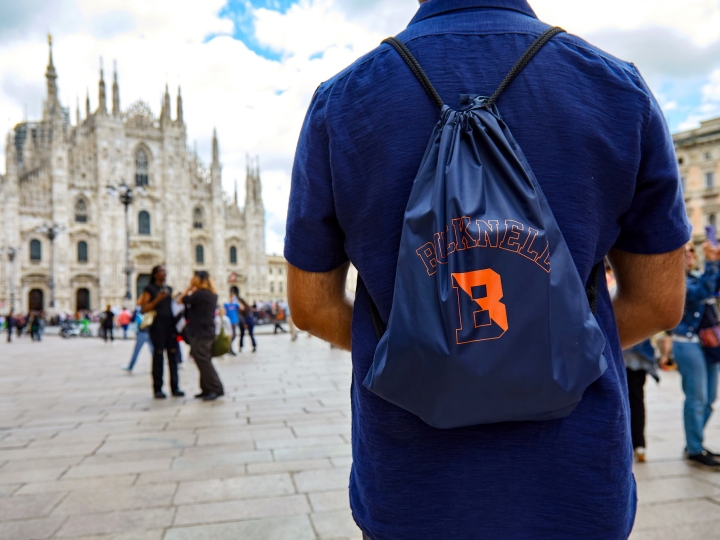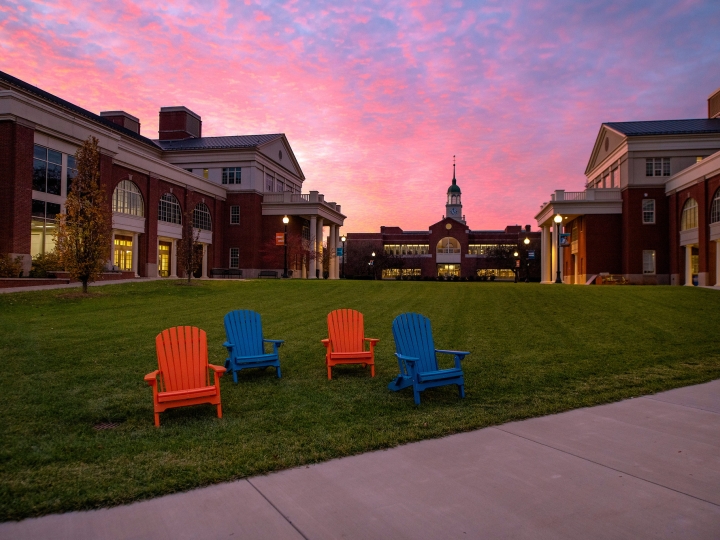
How to Plan the Ultimate College Visit Road Trip
May 28, 2021
Photo by Emily Paine, Communications
When planning a road trip, your options extend for miles in every direction.
You could traverse Route 66, eating only at roadside diners along the way. You could follow the Mississippi River, stopping at historic markers as you go. You could even head straight for Cawker City, Kan., to visit the world's largest ball of twine.
But if your family's vacation planning intersects with your college search timeline, then there's only one type of road trip for you.
With a full tank of gas, the perfect playlist and a well-crafted plan, you'll have everything you need to organize the ultimate college visit road trip.
A college visit road trip, typically planned during summer vacation or spring or fall break, allows families to visit several schools in a condensed period. Unlike some road trips where spontaneity is the plan, college visit road trips work best with careful planning. That way, you'll maximize every moment and get a better feeling for the schools on your list.
Follow the steps below, and you'll be on your way.
Step 1: Finalize Your List of Schools
By now you've probably created a list of schools that have caught your attention — perhaps because they offer your major, are in a good location or you know someone who had a positive experience there.
Now it's time to make the first cut. You'll want to identify which schools deserve a closer look through an in-person visit. Ask yourself: Am I interested enough in this school to want to spend at least two hours there — plus travel time? If the answer is yes, that's a good sign.
If you still have too many schools on your list, consider assigning each one a grade — 1 to 10 — based on your level of interest. Then determine which grade a school must receive to warrant an in-person visit. Perhaps every school with a 7 or higher makes the cut. Still too many? Raise the floor by another point and count again.
Remember that your cuts aren't permanent. You can always plan later one-off visits to schools you skipped if you think they deserve another look.
Step 2: Group Your Finalists Geographically
Whether your finalists number seven or 27, you'll want to put them all onto a map to see if any natural geographic clusters emerge.
Choose an offline or online solution based on your preference. You could plot the schools as dots on a printed map or atlas. Or you could use a free tool like Google My Maps to create a custom map you can share with family and friends.
With your finalists plotted, try to look for schools you can group together. Find the driving times between schools in a similar cluster. How long will you need to visit all the schools in that cluster? Are there any natural "pairs" of schools — perhaps two in the same city — you could visit in the same day?
Step 3: Make a Spreadsheet
Create one spreadsheet for each geographic cluster of schools.
Make one column for the school's name and another for the address of the Office of Admissions, or wherever tours begin. Make seven more columns — one for each day of the week.
Next, visit that school's Admissions page to see when tours and scheduled visits are offered. Plot that information into the columns on your spreadsheet.
Taking time to create this spreadsheet will save you time when planning your route in the next step. You'll be able to easily see whether your plan to visit School A on Friday, Schools B and C on Saturday and School D on Sunday could even work.
Step 4: Design Your Route and Plan
With all the pieces assembled, it's time to put the puzzle together. Start designing the route so you can visit as many schools as possible without doubling back or going too far out of your way.
To minimize stress and allow yourself time to explore the school and surrounding area — maybe even grabbing lunch on campus and visiting some shops downtown — try to plan one school visit per day. Two in a day is doable, but any more than that and you risk everything blurring together in your mind.
This is also the stage when you'll want to begin registering for visits and tours — even before booking hotel rooms.
While some schools welcome unannounced or walk-in visitors, many require reservations in advance — especially for experiences that have limited capacities, such as information sessions, tours and lunches with students.
You might find that school visit schedules don't align perfectly with your plan, and that's fine. For a few schools on your list, perhaps those a little lower in your rankings, you might need to plan for an unannounced visit.
That might mean you don't book an info session or campus tour but still spend an hour walking around the campus. Many schools, like Bucknell, offer self-guided tours or driving tours for this exact purpose.
One more note about planning your route: Once you've booked your campus tours, start planning other ways to get to know the town. Scout out a local lunch spot, museum or state park to get a better feel for what college life might be like in each community you visit.
Step 5: Maximize Each Stop
During your college visit road trip, make the most of each college you visit. Here are some ideas:
- Follow the school's social media accounts. A college or university's official social media channels can give you a good idea of what life on campus is like as well as the latest news. If the school has any Admissions-specific accounts, follow those, too. These can be a great way to get to know a school — plus they might alert you to any last-minute changes to campus visit offerings.
- Ask the right questions. Choose some ideas from this list of 80 questions to ask on your college tour, or come up with your own.
- Take notes. All those college visits can start to blend together — especially a few weeks after you get home. Prevent that by taking good notes, writing down things you liked and didn't like. You might even jot down some details to jog your memory later, such as what the tour guide was wearing, what you ate or something funny that happened during the tour. Many students say the best time to take these notes is right when you get in the car after the visit.
- Talk to students. Your tour guide is an expert in answering your questions and giving you a comprehensive overview of life at that school. But, in most cases, they're also getting paid to do that job. To make sure you also get an unfiltered view, ask a few students what they like and don't like about that particular college. It might be awkward to approach a stranger like that, but you'll be glad you asked.
Step 6: Remember That You’re on Vacation
In many ways, a college visit road trip is like a business trip. You're there to complete a task: find out firsthand which colleges feel right.
But just because the trip has a defined purpose doesn't mean it can't be enjoyable, too. In some families, this might be one of the last times everyone gets to take a trip together before you're off to college.
Enjoy the moments you have together. Resurrect an old driving game you used to play as a kid, like finding license plates from as many different states as you can. Schedule some days where you don't visit any schools but do some sightseeing instead. Take turns being the in-car DJ.
College is the ultimate journey, so why not plan a college visit road trip to match?
Reminders and Tips
- Take the journey with a friend. If you have a friend whose college list is similar to yours, see if your families can take the trip together. You'll have fun, be able to compare notes with your friend and could even save on lodging or gas.
- Pace yourself. Try not to overschedule or plan unrealistically. For example, if a campus tour ends at 5 p.m., you might not want to drive three hours to get to the next hotel in the city where you have a 9 a.m. tour the next day.
- Stay hydrated. You'll be outside a lot during this college road trip, so prepare like an athlete. Eat high-energy food, drink lots of water and get some rest.
- Take pictures. Just like notes can jog your memory (Step 5), pictures can have the same effect. After each visit, take a few minutes to move your favorite photos into a special album on your phone. When you get home, you'll have a complete slideshow you rewatch as needed.
- Talk to your high school counselor. Check with your high school's college counselor, if there is one. This person might have some road trip planning trips specific to your area. There's a good chance someone from your high school has planned a trip similar to the one you're about to enjoy.

We did this whole marathon road trip — two or three schools a day, all over the East Coast. A lot of the schools were more in the city, but I got to Bucknell and I thought the town was so cute.
Ashlyn Ramos ’22, a computer science major from Sammamish, Wash.

